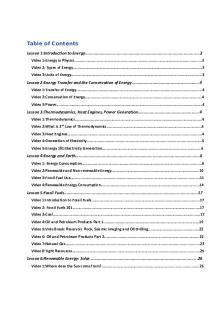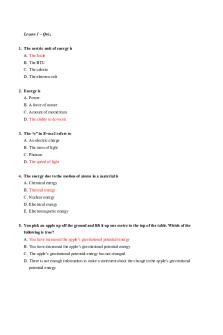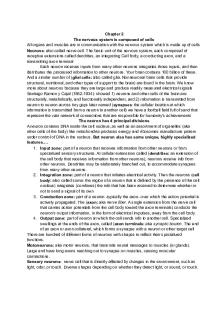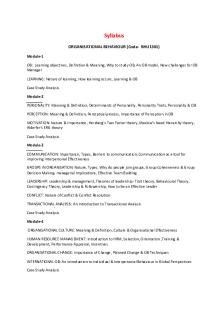PHYS 273 FULL Notes PDF

| Title | PHYS 273 FULL Notes |
|---|---|
| Author | blue queen |
| Course | Energy and Environment |
| Institution | Concordia University |
| Pages | 97 |
| File Size | 5.9 MB |
| File Type | |
| Total Downloads | 203 |
| Total Views | 277 |
Summary
Table of Contents Lesson 1:Introduction to Energy.............................................................................................. Video 1:Energy in Physics................................................................................................................... Video 2: Types ...
Description
Table of Contents Lesson 1:Introduction to Energy..............................................................................................3 Video 1:Energy in Physics...................................................................................................................3 Video 2: Types of Energy....................................................................................................................3 Video 3:Units of Energy......................................................................................................................3
Lesson 2:Energy Transfer and the Conservation of Energy.......................................................4 Video 1:Transfer of Energy.................................................................................................................4 Video 2:Conservation of Energy.........................................................................................................4 Video 3:Power....................................................................................................................................4
Lesson 3:Thermodynamics, Heat Engines, Power Generation..................................................4 Video 1:Thermodynamics...................................................................................................................4 Video 2:What is 2nd Law of Thermodynamics.....................................................................................4 Video 3:Heat Engines.........................................................................................................................4 Video 4:Generation of Electricity........................................................................................................5 Video 5:Energy 101:Electricity Generation.........................................................................................6
Lesson 4:Energy and Earth.......................................................................................................6 Video 1: Energy Consumption............................................................................................................6 Video 2:Renewable and Non-renewable Energy...............................................................................10 Video 3:Fossil Fuel Use.....................................................................................................................11 Video 4:Renewable Energy Consumption.........................................................................................14
Lesson 5:Fossil Fuels..............................................................................................................17 Video 1:Introduction to Fossil Fuels.................................................................................................17 Video 2: Fossil Fuels 101...................................................................................................................17 Video 3:Coal.....................................................................................................................................17 Video 4:Oil and Petroleum Products Part 1......................................................................................19 Video 5:Vide Break: Reservoir Rock, Seismic Imaging and Oil Drilling..............................................22 Video 6: Oil and Petroleum Products Part 2......................................................................................22 Video 7:Natural Gas.........................................................................................................................23 Video 8:Tight Resources...................................................................................................................25
Lesson 6:Renewable Energy: Solar.........................................................................................26 Video 1:Where does the Sun come from?........................................................................................26
1 PHYS 273 Video 2:The Suns Energy..................................................................................................................26 Video 3: Solar thermal 101...............................................................................................................28 Video 4: Using Solar Energy Directly.................................................................................................28 Video 5:Solar Thermal Electricity Production...................................................................................29 Video 6:The Future of Solar Power..................................................................................................30 Video 7:Photovoltais Electricity Production Part 1...........................................................................30 Video 8:Video Break.........................................................................................................................31 Video 9: Photovoltaic Electricity Production Part 2..........................................................................31 Video 10:Video Break.......................................................................................................................32 Video 11: Photovoltaic Electricity Production Part 3.........................................................................33
Lesson 7:Renewable Energy: Other Types..............................................................................33 Video 1:Hydropower 101.................................................................................................................33 Video 2:Hydropower........................................................................................................................33 Video 3:Wind Power 101..................................................................................................................36 Video 4:Wind power........................................................................................................................36 Video 5:Geothermal 101..................................................................................................................38 Video 6:Biomass 101........................................................................................................................39 Video 7:Hydrogen 101......................................................................................................................40 Video 8:Tidal Power 101...................................................................................................................41
Lesson 8:Nuclear Energy........................................................................................................41 Video 1:Nuclear Energy....................................................................................................................41 Video 2:Introduction to Nuclear Energy...........................................................................................42 Video 3:Use of Nuclear Energy.........................................................................................................44 Video 4:Nuclear Accidents................................................................................................................46 Video 5:Nuclear Future....................................................................................................................47
Lesson 9:Energy Conservation...............................................................................................48 Video 1:Introduction Energy Conservation.......................................................................................48 Video 2:Heating................................................................................................................................49 Video 3:Water Heating.....................................................................................................................52 Video 4:Appliances and Lighting.......................................................................................................53
Lesson 10:Golbul Effect Pollution...........................................................................................55 Video 1:Introduction to Pollution.....................................................................................................55 Video 2:Air Pollution........................................................................................................................57
2 PHYS 273 Video 3:Water Pollution...................................................................................................................60
Lesson 11:Global Effects: Climate Change..............................................................................64 Video 1:Is the Earth warming...........................................................................................................64 Video 2:Earths thermodynamics......................................................................................................66 Video 3:Carbon................................................................................................................................68 Video 4Effects...................................................................................................................................70
Lesson 12:Climate Sustainability............................................................................................74 Video 1:Predictions..........................................................................................................................74 Video 2:impacts...............................................................................................................................78 Video 3:Adaption.............................................................................................................................81 Video 4:Mitigation...........................................................................................................................86
3 PHYS 273
Lesson 1:Introduction to Energy Video 1:Energy in Physics
Work: Transfer of Energy o Work = Force x Distance Energy: Ability to do Work
Video 2: Types of Energy
Chemical Energy: The energy stored in certain chemical or materials that can be release by chemical reactions o Burning of materials, natural gas, coal, or oil release chemical energy in the form of heat energy o Charged electric batteries o Food in your stomach Kinetic Energy: The energy an object has due its motion o This type of energy is mechanical energy o KE=.5mv^2 Potential(Gravitational) Energy: is associated with the position of an object when some force is acting on it o Most common is gravitational potential energy Higher = more potential energy o Also a type of mechanical Energy Thermal/Heat Energy: The energy associated with random molecular motions within any substance o Increase in heat E results in a temp increase, and vice versa Electrical Energy: energy stored by charges in their electric fields o Not visible Electromagnetic Radiation: in the form of a wave that carries energy o Called light o Can be visible or not Nuclear/Mass Energy o Einstein’s theory of relativity predicts that there is relation between mass and energy Mass can be converted into energy and vice versa E=mc^2
Video 3:Units of Energy
Joule o Metric unit of energy o 1J= 1Nm o W=Fd British thermal Unit(BTUs) o Fuel and insulations o 1 BTU= amount of heat E to raise temperature of 1 pound of H2O by 1F Calorie(C )
4 PHYS 273
o Amount of E to raise(lower) temperature of 1g of H2O by 1C o In NA the calories on food labels is actually kilocalories Foot- Pound o No longer used Electron Volt(eV) o Small amount of W which is useful when working with tiny charges particles(electrons) o Amount of E gained if an electron is accelerated by 1V electric potential
Lesson 2:Energy Transfer and the Conservation of Energy Video 1:Transfer of Energy
Energy can be transformed from one type to another We can track the transfer of Energy form one transfer to another o Can be simple or complex
Video 2:Conservation of Energy
Law of Conservation of Energy: Total energy in a isolated system cannot change Isolated system: Energy can neither enter or leave The total amount of energy is conserved, it can be transferred from one form to another, but not created or destroyed Only true closed systems is the entire universe
Video 3:Power
Power: is the rate at which energy is consumed or produces Metric unit is watts(W) =J/s Power =Energy/time
Lesson 3:Thermodynamics, Heat Engines, Power Generation Video 1:Thermodynamics
1st law of Thermodynamics: The change in internal energy of a system equals the net heat transfer into the system minus the net work done by the system o This is the same as the principle of conservation of energy nd 2 law of Thermodynamics: Heat(or energy) transfer occurs spontaneously from higher to lower temperature bodies, but never in reverse Many process occur spontaneously in one direction o Irreversible nd 2 law of Thermodynamics in terms of Entropy: In an isolated system entropy increases over time
Video 2:What is 2nd Law of Thermodynamics
YouTube video
Video 3:Heat Engines
Heat energy released by burning a single match is about the same amount of energy required to lift a pint of beer up to the top of Montreal’s tallest building When we burn hydrocarbons heat energy is released through 2 chemical reactions o C + O2 => C02 +heat energy
5 PHYS 273
o H2 + O => H20 + heat energy Heat Engine: is any device that take energy from a warm source and convert a fraction of this heat energy to mechanical energy o Relies on temperature difference between the heat source and the heat sink(cold)
o Efficiency o The efficiency of a heat engine tells us how much of the input heat energy is turned into useful mechanical work o Due to second law of thermodynamics it is not possible to turn all input energy into mechanical energy work done Efficiency= ∗100 % o energy put into system T o Efficiency ( best )= 1− cold ∗100 % T hot
(
)
(
)
Video 4:Generation of Electricity
Current can produce magnetic field, and the vice versa is possible as well Faraday’s Law of Induction: describes how changing the magnetic fields through a wire coil results in an electrical current through that coil Through the process of electrical induction mechanical energy can be transformed into electrical energy By turning the wire loop(mech energy) the magnetic field passing through the loop changes which generated a current(electric energy)
Most electricity we use if from conversion of mechanical energy to electrical energy using a generator
6 PHYS 273
o The mechanical energy can come from many sources o Example Burning fossil fuels to turn turbines Wind Water Power Plants and Efficiency
Video 5:Energy 101:Electricity Generation
YouTube video
Lesson 4:Energy and Earth Video 1: Energy Consumption
Energy use Per Capita o Amount of energy used per capita varies greatly from country to country o General wealthier countries use more energy per person o Approximately 20% of the world’s population live in highly developed countries o These countries account for 60% of the worlds energy use
7 PHYS 273 o
o
o Energy use per capita: Some growth (increase in the last decade)
8 PHYS 273 o
o Due to economy growing Total Consumption Region o In BTU
Total Energy Consumption by Country
9 PHYS 273
Energy Use per Capita o Exact numbers regarding how energy is consumed varies o In general most developed countries have similar distribution as the USA o Production varies more by country o
Projected: World o Projections for world energy consumption show an increase overall o OECD countries at a slower rate than non-OECD countries
10 PHYS 273
o Projected: Canada Canada shows growth similar to average OECD countries Rate of change of energy consumption depends on which sectory End-Use by Sector
Video 2:Renewable and Non-renewable Energy
Non-renewable resource: that that can be exhausted within a relatively short time as result of our exploiting them o Fossil Fuels Coal Oil Natural gas
11 PHYS 273
Depleted on a time scale of ~100s years Being produced all the time but on a scale of 100s of millions of years(too slow) o Uranium 235 Used for nuclear fission power generation Could be depleted over several decades if used more vigorously than they are not o Geothermal Both renewable and non-renewable Lifetime of geothermal sites caries form site to site Renewable resources: can never be consumed to completion o Based on Solar Energy Direct Sunlight Wind Hydroelectric Ocean Currents Ocean Thermal Biomass Limited only by the lifetime of the sun The rate of use does not affect he lifetime of source o Not based on Solar Energy Geothermal: can be locally depleted but will renew of 100s of years Tidal: comes from gravitation energy between Eartha and moon
Video 3:Fossil Fuel Use
Fossil Fuel Consumption (% of Total)
Fossil Fuel Energy Consumption o In highly developed countries the % of fossil fuel consumption is decreasing o Does not mean total consumption is decreasing
12 PHYS 273
o Change in Coal Consumption o In NA and Europe coal consumption has been in decline o NA has seen a 20% decline since its peak in 2007 o Coal use in ASIA has been steeply increasing
Change in Oil and Natural Gas Consumption o Petroleum consumption has plateaued o Natural gas consumption has been increasing o
Coal Consumption by World Region o Coal consumption growing rapidly in ASIA
13 PHYS 273
o Petroleum Consumption by Region o EU and NA still major consumers, although use has plateaued o Asia has become a min consumer and use is increasing
o Natural Gas Consumption by World Region o Consumption is increasing in NA o NA is highest consumer o Use is also increasing in other regions
o
14 PHYS 273
Fossil fuel Trends o Overall consumption increasing o Almost all countries are at least 50% dependent on fossil fuels o Amount of fossil fuel uses varies by Region Type of fuel o But the overall consumption of petroleum (oil), coal, and natural gas are on the rise With the exception of the very recent past for coal Sankey Diagram: Canada o Coal: used mostly for the of electricity o Oil: used widely except in electricity generation o Natural Gas: most sectors except in transportation
o
Video 4:Renewable Energy Consumption
Alternative and Nuclear Energy o Clean Energy is non-carbohydrate energy that does not produce carbon dioxide when generated. It includes hydropower and nuclear, geothermal and solar power among others
15 PHYS 273
o Alternative and Nuclear Energy: % of total energy use o Alternative energy is becoming more popular o Strong link between country’s income and use of alternative energy
o
Sankey Canada o The vast majorit of renewa...
Similar Free PDFs

PHYS 273 FULL Notes
- 97 Pages

PHYS 273 Full Class Notes
- 80 Pages

Phys-273-Notes - Lecture notes 1-12
- 55 Pages

PHYS 273 NOTES INCLUDING test bank
- 50 Pages

PHYS 273 Midterm Notes Lessons 1-7
- 61 Pages

PHYS 273 QUIZ Question BANK
- 9 Pages

PSYC 273 Chapter 2 Notes
- 10 Pages

Phys 91173 electrcity notes
- 8 Pages

FULL Notes
- 229 Pages

Full notes
- 102 Pages

1189 BIOL 273 - course
- 14 Pages

PHYS 1000 - Unit 3 Notes
- 7 Pages

MIE 273 syllabus S18-10
- 4 Pages
Popular Institutions
- Tinajero National High School - Annex
- Politeknik Caltex Riau
- Yokohama City University
- SGT University
- University of Al-Qadisiyah
- Divine Word College of Vigan
- Techniek College Rotterdam
- Universidade de Santiago
- Universiti Teknologi MARA Cawangan Johor Kampus Pasir Gudang
- Poltekkes Kemenkes Yogyakarta
- Baguio City National High School
- Colegio san marcos
- preparatoria uno
- Centro de Bachillerato Tecnológico Industrial y de Servicios No. 107
- Dalian Maritime University
- Quang Trung Secondary School
- Colegio Tecnológico en Informática
- Corporación Regional de Educación Superior
- Grupo CEDVA
- Dar Al Uloom University
- Centro de Estudios Preuniversitarios de la Universidad Nacional de Ingeniería
- 上智大学
- Aakash International School, Nuna Majara
- San Felipe Neri Catholic School
- Kang Chiao International School - New Taipei City
- Misamis Occidental National High School
- Institución Educativa Escuela Normal Juan Ladrilleros
- Kolehiyo ng Pantukan
- Batanes State College
- Instituto Continental
- Sekolah Menengah Kejuruan Kesehatan Kaltara (Tarakan)
- Colegio de La Inmaculada Concepcion - Cebu


